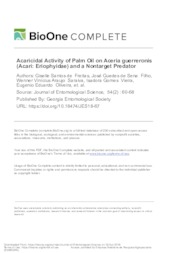Acaricidal activity of palm oil on Aceria guerreronis (Acari:Eriophyidae) and a nontarget predator.
Acaricidal activity of palm oil on Aceria guerreronis (Acari:Eriophyidae) and a nontarget predator.
Author(s): FREITAS, G. S. de; SENA FILHO, J. G. de; SARAIVA, W. V. A.; VIEIRA, I. G.; OLIVEIRA, E. E.; TEODORO, A. V.
Summary: The coconut mite,Aceria guerreronisKeifer (Acari: Eriophyidae), is a severe andubiquitous pest of coconut plantations worldwide. Vegetable oils contain fatty acids that areactive against a variety of agricultural pests; however, little is known about their efficiency incontrollingA. guerreronisas well as their adverse effects on its natural enemies. Here, weassessed the chemical profile of palm oil as well as its toxicity and repellence to bothA.guerreronisandTyphlodromus ornatusDenmark and Muma (Acari: Phytoseiidae), a naturalenemy of the pest. Oleic, palmitic, and linoleic acids accounted for over 85% of palm oil fattyacid composition. Also, palm oil was approximately 4-fold more toxic to the coconut mite thanto its predator. Furthermore, the lethal concentration percentage (LC)50and LC99of palm oilindicated greater activity against the coconut mite than to its predator. Therefore, by exhibitinghigher toxicity and repellence to the coconut mite, with substantial selectivity to the predatorT.ornatus, palm oil is a promising tool to be integrated in the control ofA. guerreronisin coconutplantations.
Publication year: 2019
Types of publication: Journal article
Keywords: Coco, Coconuts, Controle Biológico, Fatty acids, Plant pests, Praga de Planta, Ácaro, Óleo Vegetal
Observation
Some of Embrapa's publications are published as ePub files. To read them, use or download one of the following free software options to your computer or mobile device. Android: Google Play Books; IOS: iBooks; Windows and Linux: Calibre.
Access other publications
Access the Agricultural Research Database (BDPA) to consult Embrapa's full library collection and records.
Visit Embrapa Bookstore to purchase books and other publications sold by Embrapa.

